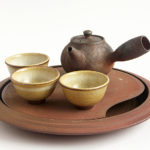How did Mirka start to make tea boats (or tea seas)? We have known potters Petr Novák and Mirka Randová for seven years. They both create teaware in their own specific way. We asked Mirka a few questions about the phenomenon of tea boats, which we keep discovering, using and – most importantly – admiring.
Mirka, do you know how old the phenomenon of tea boats and tea draining trays is? I mean in tea culture in general…
It’s hard to say. Various shapes and kinds are used, from small tea tables, draining trays, bowls and stones to the best known bamboo tea boats. I guess the most frequent is the use of the tea boat in the Gongfu tea ceremony. Its history probably reaches back to the 18th century.
How long have you been making tea pottery, specifically tea boats? Who or what inspired you?
I was first inspired to make tea boats during my visit to the 2008 Tea Bowl Festival in South Korea where they are traditionally made. I was more into bonsai bowls at that time and it was actually Petr who tried to make the first boat – chiefly to use it for himself. One day I was finishing an oval bonsai bowl and suddenly the idea crossed my mind that this would be an interesting shape for a tea boat! As I overcame the fear of breaking the tradition of shapes that originally inspired me, it started working on its own. Today I enjoy creating new shapes; the last ones, for instance, were inspired by the plates I designed and made for restaurants I work with.
Did you start with the large tea boats with a removable top straight away? I imagine you had to work your way to them.
The removable top was there from the beginning; the closed boats with one larger opening for spilling out water never really resonated with me – probably because I could not imagine the maintenance (note: the type of boats with one opening is known in Korea, for instance). Size-wise I used to start with what is today my mid-size, around 40 cm. The training I got from bonsai bowls helped and boats were similar to make. Also, despite being artworks of their own, in the end they are always accessories for something else. The bonsai bowl accessorises a tree; together they create a symbiosis, while the boat accessorises a teapot and a cup. This effectively limits the creative process, on the other hand it is a huge challenge.
When you are creating a boat, do you have in mind a particular material or style of the teapots and cups?
I don’t plan my boats to go with concrete materials or styles of teaware. I rather concentrate on the bringing out of the beauty of teaware in general. I assume that the pot with tea is the centre of events that attracts the attention of the tea master and the boat is his stage of a sort – the master has to feel comfortable there and the boat has to aesthetically emphasise what is happening on it. I have to confess that it is not always easy and that sometimes I overdo the distinctiveness of the boat. I try not to repeat mistakes. The overall understanding of whether a certain boat design works comes long after firing – when I see it in action, together with teaware. The tea community helps me a lot in this; it is great to have friends in the tea community, who test and comment on new designs. (note: we are currently testing one of Mirka’s boats in the Klasek Tea Shop)
How do you decide whether you will fire in a wood-fired (reduction) kiln or in an electric one?
This decision somehow makes itself because it depends on my original idea and is given by the material – clay and glaze – that I select. Some materials would not survive reduction, but I have a material that is very suitable for wood firing, although in 40% of the cases it doesn’t survive it either. Other materials would look boring if fired in the oxisdation atmosphere of the electric kiln and need wood firing to liven up their look. They also profit from the fly-ash and the touch of the flames, which is why wood firing is the best choice. It is similar with glazes – it is all about the materials you select.
Thank you. We are looking forward to your discoveries and products.
In the process of creating my pottery, form – shape is always very important to me. Although I equally like to work on the potter’s wheel and modelling, my approach to each of them is very different. I start modelling without any final ideas about the shape and appearance of the final piece. I only stick to the planned work procedure. The shape and appearance only arise in the working process, as a dialogue with clay. When I create my pottery on the potter’s wheel, I aim at complex forms – simple and feminine. Every part of the process of producing ceramics is an adventure, although I get most enthusiastic about making glazes from natural materials – so many choices… I believe that every piece needs a blessing of randomness. I adjust the selection of materials and type of firing to this. In a wood-fired oven, each product confirms its chance to exist, achieving its character, strength and energy from the fire.
























































